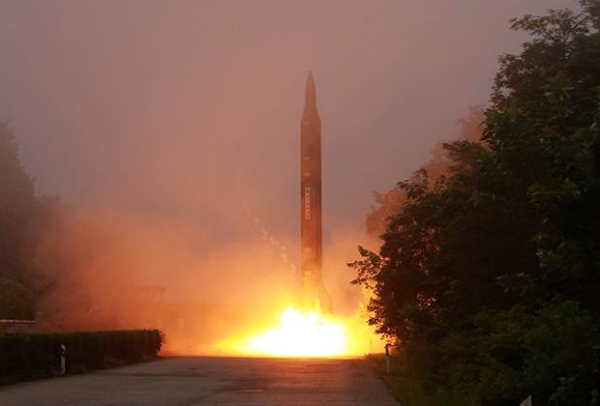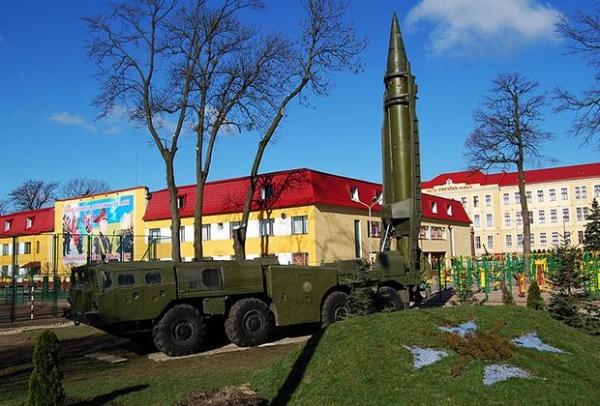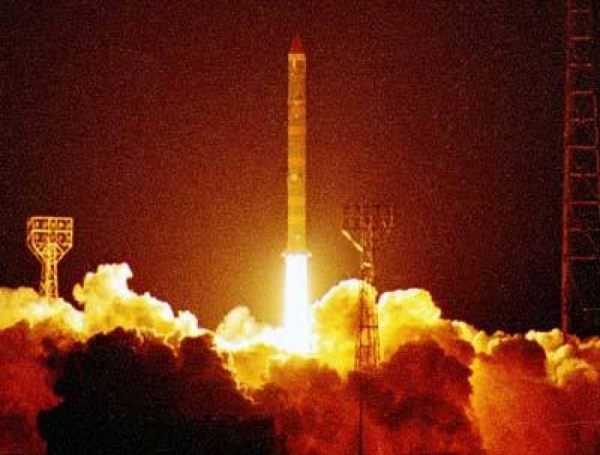
Missiles North Korea has become a favorite media bogeyman the rest of the world. Around this theme stranded a lot of myths, exaggeration, propaganda and sometimes outright lies. What are the real successes of the North’s rocket, as they were made and who helped them in mastering such complex technologies?
The missile programme of the DPRK is attracting in recent years significant attention. One of the most discussed issues was the development of current capabilities. Generally accepted perceptions of the level of development of the DPRK is not much fit with the new rocket the success of Pyongyang.
This contradiction is often explained by the fact that in fact the northerners are someone’s “clients” and, without help, they step are not able to do. It is actually much more complicated, but first we should note some nuances.
First, the DPRK remains one of the most closed countries and closed itself a nuclear missile power, so reliable information is extremely small.
Second, North Korea is surrounded by an aura as hostile propaganda and contrived sensationalism. Largely repeats the situation with the media publications about the alleged new military projects of Saddam in the 1990s. Speculation and video even more misinformation clouding the picture.
Thirdly, the dependence of northerners on external assistance varied greatly from project to project, and in General over the years, as varied and the list of the main partners in the “rocket Cup”.
Fourth, there is no uniform classification system for North Korean ballistic missiles (RB). Different sources use their own indices, but because some SCUD D can mean quite different missiles in the arsenals of the Korean people’s army (kPa).
The first teacher
Contrary to popular belief, it was not the Soviet Union. In the Kremlin since the end of the 1950s belonged to the Pyongyang wary and therefore, though it was supported in the framework of the logic block, not too spoiled by the supply of arms. It especially stood out against military aid to the Soviet Union to the Arab countries. Egypt and Syria in huge volumes and in a wide range has got what Pyongyang could not even dream of.
On the other hand, none of the DPRK to drop was not going, and in times of warming relations Union supplied military equipment in significant quantities. However, to assist in the military missile program could not be considered.
In 1965-1968 was a small delivery of the complexes 2К6 “Moon” (9 launchers, several dozens of missiles and related machinery). But this system of rockets with a diameter of 415 mm and a range of not more than 45 kilometres pale look on the background of those arsenals, which launched in those years, the United States South of the Peninsula. The Soviet Union is usually referred to the obligation to protect North Korea in case of attack, implying that “you own stocks of offensive weapons to anything”.
However, Pyongyang did not intend to rely on relationships with one ally and independently conducted information gathering about BR. Somewhere in the mid-1960s in various military universities and research institutes (then just emerging, as the country had barely completed the first phase of industrialization and in General was retarded) was engaged by BR on liquid fuel.

Test-fired missiles, “Nodong”, July 2016. Tested the version with a cylindrical-conical head part with a tapered “skirt.”
Photo: KCNA / Reuters
Carefully studied the German “V-2”. Another “training sample” was a missile from a Soviet anti-aircraft complex SA-75. Was primarily interested in liquid rocket engine. By the way, in itself, it proved so successful that in some countries was used to create BR: talking about Indian Prithvi” and the Iraqi al-Thamud-2″.
In the mid-1970s the situation has changed: came to the aid of China. In those years, China sought to increase its influence on North Korea, but Pyongyang wanted to use the Soviet-Chinese competition. North Korean specialists in 1975 managed to become members of the Chinese project to develop a new BR DF-61. The precise chronology of the participation of DPRK in the project is unknown: the sources diverge. Work began between 1975 and 1977, and was discontinued between 1977 and 1980.
If to summarize what is contained in open sources, is roughly the following. BR is a liquid, engineered in two ways. For China — with a range of 1,000 kilometers and a payload of a nuclear warhead weighing 500 kilograms. For the DPRK — with a range of 600 km and a conventional warhead weighing 1,000 kilograms. Missile length — 9 meters, the diameter of the meter.
Political change in China led first to the freezing of the project, and then to the complete abolition (1980). The Chinese since then, focusing in this class on solid rockets. However for northerners it was a good school: they gained practical experience of working together with qualified experts and familiarized with the missile technology China. It they came in handy in another project.
“Elbrus” from the country of pyramids
Back in the 1960s Pyongyang as a “brother in the struggle for national liberation against the forces of imperialism” actively intervened in the conflicts in Asia and Africa. Northerners were not only Vietnamese, but also in the Arab-Israeli wars. So, during the 1967 war in Syria were 25 pilots from the DPRK, and 30 military pilots were in Syria and Egypt during the 1973 war. Moreover, in Egypt’s North Korean pilots on the MiG-21 even engage in battles with the Israeli air force. This assistance soon fully paid off.
As already mentioned, Egypt was able to obtain from the Soviet Union what the DPRK could not even dream of, including Soviet missiles tactical and operational-tactical brigade. They-Cairo and calculated with Pyongyang.
In 1975-1976 from Egypt, there were several Soviet missile complexes “Luna-M”. To celebrate, it was decided to start “reverse engineering” in the development of its own missile production. Soon, however, the program was abolished: all the resources left on the more interesting task.
From 1979 to 1980 from Egypt delivered two or three 9К72 missile complex “Elbrus” with missiles R-17, in Western systems classification referred to as SCUD B. It was already quite a serious thing and the copying of this system was the first success of the DPRK. The more that northerners have had experience on another project with single-stage liquid short-range BD — DF-61.
In the early 1980s, the North Korean program of BR becomes in practice. Was created a working group and then the organizational structure of the defense industry departments. Started construction of infrastructure, including testing. For the first start, and chose the Cape of Moses on the sea of Japan. This is the future Vostochnobeisky spaceport, it was there and then was tested many military and space rockets of the DPRK.
In 1982, managed to more or less deal with the Soviet missile and by 1984 th ended in the creation of their prototypes. Moreover, the samples can not be called in the full sense of the words products reverse reproduction. Totally “their” was only the hull, tanks and some minor details. Engines, gyros, etc. received from other owners of the original Soviet missiles. There is information about the use of gyroscopes of the Western manufacture, also obtained through a third party. In April-September 1984) conducted a series of tests, three launches were successful. At the same time, a part of it formed the first part involved testing and refinement of regulations for the operation of the new weapons.

9К72 missile complex “Elbrus”
Photo: Bandanschik / Wikipedia
Created rocket “Hwaseong-5” differed from the Soviet original, mainly the increased range. If the original range did not exceed 300 kilometers (depending on modification and direction of flight relative to the rotation of the Earth), the North Korean adaptation overcame 340 kilometers. In 1985-86 launched serial production — at this point, the industry of the DPRK has already mastered the production of the main components of missiles.
Helped by the fact that the rocket immediately found a buyer. At this time Iran, a major arms client, led a bloody war with Iraq, has Soviet R-17. Iran was isolated and had an acute need for arms and equipment. Because Iran and North Korea, quickly agreed: Tehran received mortars, MLRS, tanks, and Pyongyang — currency and oil. Now for Iran arrived and by BR.
In June 1987, an agreement was signed about deliveries to Iran of missiles “Hwaseong-5”, the first shipment took place in July. During the “war of the cities” in 1988, when Iraq and Iran were widely used by BR against enemy cities, “Hwaseong-5” played a major role and has passed full-scale testing in combat conditions. The Iranians launched on the cities of the enemy 77 missiles. And although it is known that attempts have been much more, and even an emergency with the explosion of the missiles at launch, “Hwaseong-5” proved to be a full combat brigade. Especially in the process of the combat use of experts found flaws in the design and perfected the rocket.
However, Iraq has a new weapon — the missile al Hussein”. In fact, it is long (almost 1.5 meters) the modification of the original Soviet rockets with plenty of fuel and reduced payload. And it was made from dismantled Soviet missiles. Initially, the Assembly of one of the “al-Hussein” went three of the Soviet R-17, then the efficiency has increased, and the Assembly of the two “al-Hussein” spent three R-17. The Iraqis also used in the rocket Western components — for example, the turbopumps from Germany. In the end I managed to create a missile with a range of 600-650 kilometers, although with very low precision.
So the Iranians are ordered in the DPRK BR new with increased range. By the Northmen, too, needed a missile capable to cover the whole territory of South Korea, “Hwaseong-5” could not. Have chosen a conservative path of gradual partial improvement of the old missiles: the lighter structural materials, reducing the weight of the warhead experiments by reducing the thickness of walls of tanks. Without revolution was created by the “Hwaseong-6” in the Western sources commonly referred to as SCUD C with a range of about 500 kilometers.
The tests were in 1990-1993, partly in the territories of the partner countries — Iran and Syria. In Iran, “Hwaseong-5” and “Hwaseong-6” was put into service under the indexes “Shahab-1 and Shahab-2”, their production is gradually localized in the 1990s with the assistance of the DPRK.
In General, nothing extraordinary: not the most complex system and gradually copied, and then by making changes on its basis created a whole family of new products. The process was in the 2000s, but the story of these missiles requires a separate article.
Original art
Despite the success with tuning the old Soviet structures, the limit of capacity was evident. The military geography of the region demanded delivery systems are quite heavy (1000-1500 kg) warheads with a range of 1,000 kilometers and more to the enemy’s bases in Japan.
In the late 1980s, work began on a fully independent design, albeit based on technology “Chasanov” in terms of construction materials, fuel and control systems. The result was a rocket, received outside the country the name of “Nodong”. Iran partially funded the project and searched for the DPRK materials on world markets.

The Iranian rocket “Shahab-3” on parade in Tehran, September 2010.
Photo: Vahid Salemi / AP
It was actually created in proportion (half) enlarged model of the “Hwaseong-6” propulsion system, severely altered on the basis of the “designer” of the engines of R-17. The tests were in 1993, and the rocket came in the 1990s, adopted not only in Korea but also in Iran (Shahab-3) and in Pakistan (“Ghauri-1”).
Nothing extraordinary: extensive capacity building on the basis of well-mastered technology. The DPRK in this case were not the importer of technology, and exporter.
Damascus put the “Point”
At the time, Damascus and Pyongyang have established a very good relationship. The northerners sent pilots to Syria in 1973-1975, and in subsequent decades has supplied large amounts of military equipment, helping with upgrades (not including BR). However, Assad had something to offer Kim Jong Il.
In 1983, Syria has received the first Soviet missile systems 9K79 “Tochka” with the 9M79 solid-fuel missiles that had a range of up to 70 kilometers and a sufficiently high accuracy. In the mid-1990s in Syria with these missiles were able to see specialists to North Korea in 1996, Pyongyang got a few rockets to explore.
In 2005 took place the first successful test of the local option — solid fuel BD KN-02. That is an option, not a clean copy. The fact that the North Korean version of the characteristic is increased range on the first testing, it has about 100-120 miles, and in the process of modernization (according to estimates by foreign intelligence services) the KN-02 was able to achieve a range of over 200 kilometers.
Former pupils
First, Iran was a net importer of missile technology and technology from the DPRK. Until the 2000s, namely, the Korean side was “attracted” in this duet. However, as the General economic and technological growth Iran has launched multiple missile programs.
Because of the huge difference in resources available, the Iranians have achieved a number of successes before former teachers. So, Iran has put its satellite into its launch vehicle in 2009, while the DPRK succeeded only in 2012. However, Iran during the second half of the 2000s was the main testing ground of the duet. Very much of what the Iranians have shown in the 2000s, the northerners showed then in 2010. it is Obvious that the Iranians of the students have become at least equal partners.
Since the 2000s the missile troops of the two countries engaged in the study and reconstruction of a number of Soviet technology, access to which was closed prior to the collapse of the Soviet Union. In the 1990-ies dramatically and become unmanageable many examples of Soviet equipment, technical documentation, as well as experts of the defense who led a miserable a miserable existence and are willing to work for peanuts. In the former Soviet Union then traveled about the scouts not only from Korea but also from South Korea, China and other countries. In the 2000s, the order was brought, but managed to leak a lot. In those same years, the US has declassified (as “historical”) information about military and space rocket programmes between 1950 and 1970. this information is also carefully collected and studied.
On the decommissioned Soviet BR in the DPRK — an obvious disinformation made by the Northmen level is not required. They might borrow someone else’s decisions and not do stupid copying, and independent “creative explanation”. For borrowing in the vastness of the collapse of the Soviet Empire, a lot of what could be profit — albeit in the form of fragments of a huge jigsaw puzzle but not the whole set was needed, much to think through themselves.

Test-fired missiles, “Hwaseong-10 June 2016.
Photo: KCNA / Reuters
Apparently, the inspiration really was a Soviet marine BR, the R-27. A number of decisions in the second stage a successful launch of the Iranian space vehicle “Safir” (2009) and tested in 2016, the North Korean rocket “And 10” clearly indicate this. It’s not only about the layout solutions of the propulsion system, but also about choosing a pair of “fuel — oxidant”. Recent tests show that the achieved technological level comparable with the Soviet R-27. However, “Hwaseong-10” clones R-27 are not.
Even more interesting is that the test is now a solid BR for submarines never seen foreign direct prototype.
And what does it all mean?
Only that the Genie is already out of the bottle: the DPRK became a full-fledged missile power, and much more independent than people think.
They have gone from studying the missiles of the Second world books copy received in hardware to the Soviet missiles. Having mastered the serial production of the components of these missiles and the Assembly that started to create more sophisticated versions. In parallel he developed a completely new missile based on the same technology. And started a very successful design of the new missile on the basis of other, more modern technologies.
At the same time, there is no need to obtain the technique ready to use. Now all in the hands of local techies. Modern fruits of labor of North Korean engineers will be discussed in a separate article.








